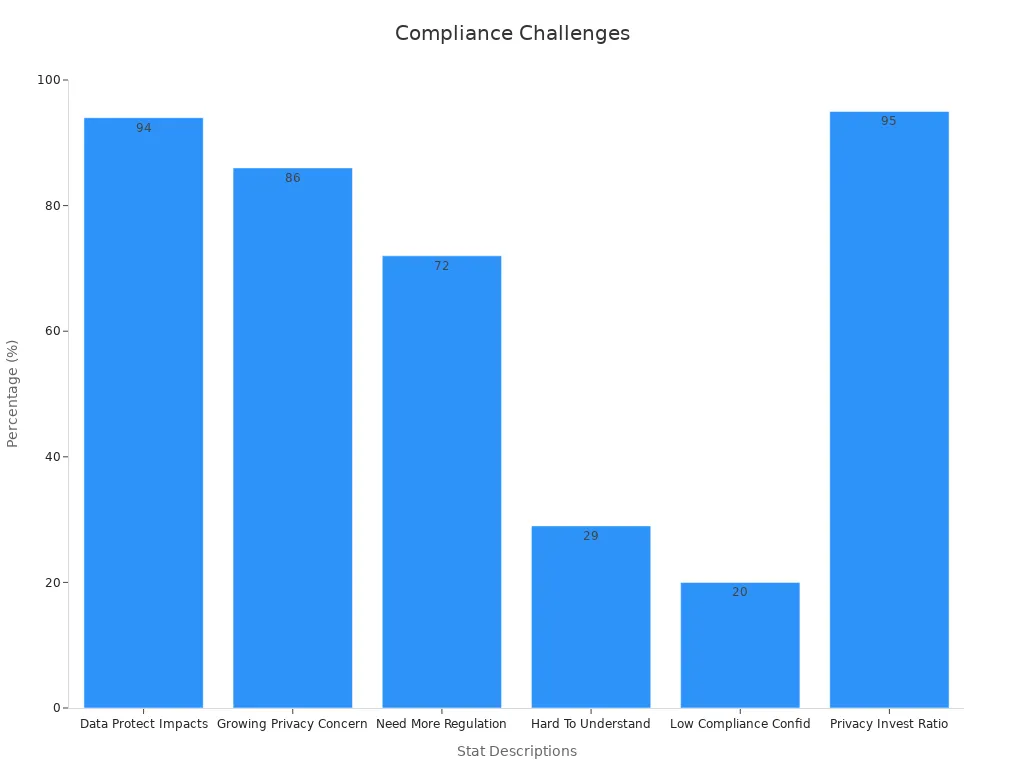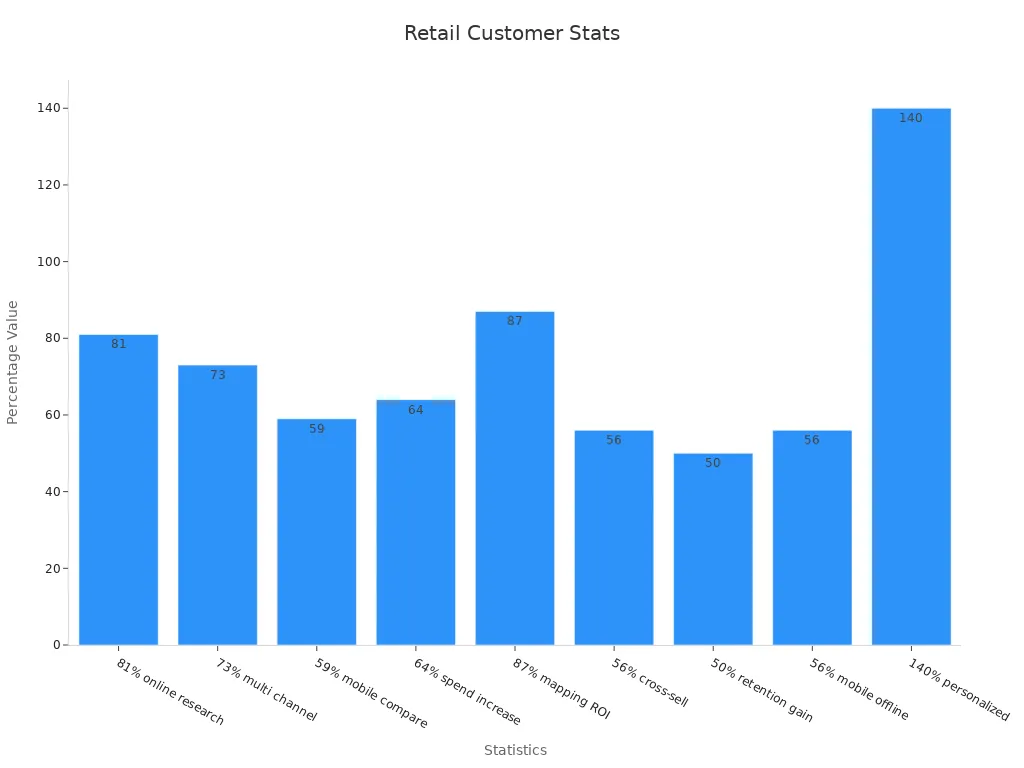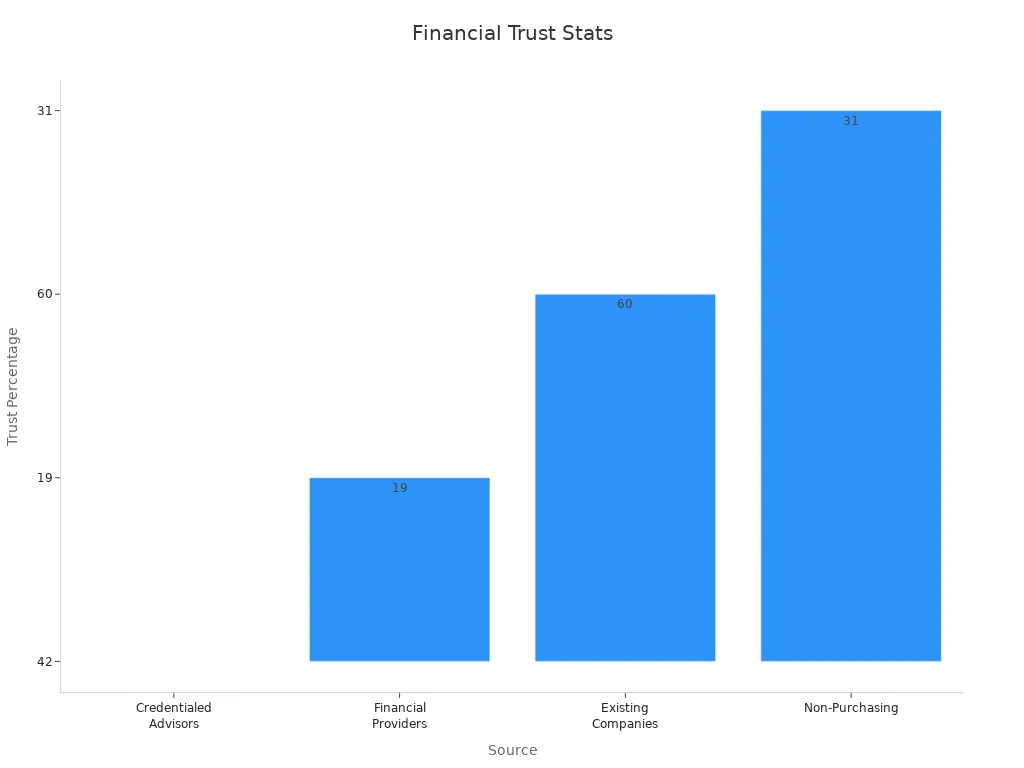Mapping a Single Customer View Across Online & Offline Touchpoints

A Single Customer View consolidates data from every interaction you have with your customers—both online and offline—into one unified profile. This approach helps you understand their preferences, behaviors, and needs, enabling you to provide consistent and personalized experiences. For instance, 79% of customers now expect seamless interactions across all channels, and 80% are more likely to purchase from businesses that deliver personalization.
Today’s customer journey spans multiple touchpoints, from social media to in-store visits. On average, consumers spend 6.5 hours online daily but still value physical shopping. Without a unified view, you risk fragmented experiences that could drive customers away.
Key Takeaways
A Single Customer View gathers all customer info into one profile. This helps businesses understand what customers like and how they act.
Giving customers personalized experiences makes them happier and more loyal. This boosts sales and lowers costs for customer service.
Combining data is important. Removing barriers helps businesses make smarter choices and work better.
Connected analytics give useful ideas. These help businesses predict trends and improve how they connect with customers.
Following privacy rules is very important. Being clear builds trust and follows laws like GDPR and CCPA.
Why a Single Customer View is Essential
Personalizing Customer Experiences Across Channels
A Single Customer View empowers you to deliver personalized experiences across every channel your customers interact with. By consolidating data from online and offline touchpoints, you gain insights into individual preferences and behaviors. For example, companies that excel in customer experience achieve twice the revenue growth compared to their peers. Personalized interactions also boost customer satisfaction, which can reduce service costs by up to 20%.
When you tailor your messaging and offers to match customer needs, engagement increases. Starbucks demonstrated this by personalizing 400,000 messages, resulting in a threefold increase in offer redemptions. Metrics like conversion rates and customer lifetime value highlight the financial benefits of personalization. With a unified view, you can create meaningful connections that drive loyalty and long-term success.
Enabling Data-Driven Business Strategies
Data is the backbone of effective decision-making. A Single Customer View allows you to harness the power of unified data to inform your strategies. Businesses with superior customer experience often see operational efficiency improvements, such as a 1% increase in First Contact Resolution, which reduces operating costs by the same percentage.
Unified profiles help you identify trends and opportunities across channels. For instance, tracking revenue per user can reveal the impact of personalization efforts. Companies that measure metrics like Net Promoter Score (NPS) grow twice as fast as competitors. By leveraging these insights, you can optimize campaigns, allocate resources effectively, and maximize ROI.
Bridging Online and Offline Customer Interactions
Integrating online and offline data creates a seamless omnichannel experience. Customers perceive greater value when businesses combine the advantages of both channels. Positive interactions between online and offline touchpoints enhance overall evaluations, making customers more likely to return.
For example, online convenience influences offline experiences, such as in-store visits. A study found that blending these channels creates a synergistic effect, improving the shopping journey. With a Single Customer View, you can unify these interactions, ensuring consistency and enhancing customer satisfaction. This approach builds trust and strengthens relationships, positioning your business for long-term growth.
Challenges in Achieving a Single Customer View
Overcoming Data Silos and Fragmentation
Data silos are one of the biggest obstacles to creating a unified customer profile. When data is stored in separate systems or departments, it becomes fragmented and difficult to access. This fragmentation leads to inefficiencies and missed opportunities.
Impact Type | Description |
|---|---|
Operational Inefficiency | Data silos create bottlenecks and redundancies, delaying customer service responses and impacting satisfaction. |
Impaired Decision-Making | Incomplete information from silos leads to poor decisions, such as marketing strategies missing customer feedback. |
Missed Opportunities | Isolated data sets can misalign strategies between departments, resulting in lost sales and missed product feedback. |
Measuring the Impact | KPIs like customer satisfaction scores and time-to-market can indicate the negative effects of data silos. |
To overcome these challenges, you need to break down silos by integrating data across systems. Techniques like ETL (Extract, Transform, Load) and real-time integration can help unify data. Centralized repositories, such as data warehouses or data lakes, also play a key role. Additionally, fostering collaboration among departments ensures that everyone works toward the same goal.
Addressing Inconsistent Data Across Touchpoints
Inconsistent data is another hurdle in achieving a Single Customer View. When data from different touchpoints doesn’t align, it creates confusion and reduces the accuracy of customer profiles. For example, a customer’s name might appear differently in your online store and in-store database.
To measure and improve data consistency, you can track key metrics:
Metric | Description |
|---|---|
Completeness | Refers to the presence of all required information within a dataset. |
Validity | Describes the conformance of data to business rules such as format and allowable data types. |
Timeliness | Refers to whether the information is sufficiently up-to-date for its intended use. |
Consistency | Present when all representations of a particular item across multiple data stores match. |
Standardizing data formats and implementing strong data governance practices can address these inconsistencies. Documenting data assets and mapping data flows also ensure that information remains accurate and reliable.
Navigating Privacy and Compliance Requirements
Privacy regulations add another layer of complexity to creating a unified customer profile. Laws like GDPR and CCPA require you to handle customer data responsibly. Non-compliance can lead to hefty fines and damage to your reputation.
Statistic | Source |
|---|---|
Cisco | |
86% of the US general population say data privacy is a growing concern for them. | KPMG |
72% of Americans believe there should be more government regulation on what can be done with personal data. | Pew Research Center |
Only 29% of consumers said it is easy for them to understand how well a company protects their personal data. | International Association of Privacy Professionals |
To navigate these challenges, you must prioritize transparency and compliance. Implementing a robust privacy framework ensures that you meet regulatory requirements while building trust with your customers. Regular audits and updates to your data practices help you stay ahead of evolving regulations.

By addressing these challenges, you can create a reliable and compliant Single Customer View that enhances customer experiences and drives business success.
Steps to Map a Single Customer View

Identifying Key Online and Offline Touchpoints
Mapping a Single Customer View begins with identifying the touchpoints where your customers interact with your brand. These touchpoints span both online and offline channels, and understanding them is crucial for creating a unified profile.
Description | |
|---|---|
In-store Interactions | Direct, personal engagements within a physical retail environment that significantly influence decisions. |
Traditional Media | TV, radio, and print advertising that still play a role in consumer behavior despite the digital shift. |
Direct Mail Campaigns | Tangible marketing tools that yield high response and conversion rates through targeted campaigns. |
Word-of-Mouth Marketing | Recommendations and reviews that heavily influence consumer decisions, with 86% of customers relying on them. |
To identify these touchpoints, you should map the customer journey. This process involves analyzing where customers engage with your brand, from browsing your website to visiting your store. By doing this, you can uncover gaps and opportunities to improve their experience. For example, tracking in-store interactions alongside online behaviors helps you understand how digital convenience impacts physical visits.
Collecting and Integrating Data from Multiple Sources
Once you’ve identified the touchpoints, the next step is to collect and integrate data from these sources. Data integration ensures that information from various channels—such as social media, email campaigns, and in-store purchases—comes together in one place.
Tip: Use both qualitative and quantitative methods to gather data. Surveys, interviews, and analytics tools can provide a comprehensive view of customer behaviors and preferences.
Here’s a step-by-step approach to guide you:
Gather data from all relevant sources, ensuring you include both online and offline interactions.
Create customer personas to represent different segments.
Identify customer touchpoints throughout the journey.
By integrating this data, you can identify patterns and trends that inform your strategies. For instance, combining online browsing data with in-store purchase history can reveal which products resonate most with your audience. This insight allows you to tailor your marketing efforts and improve customer satisfaction.
Unifying Customer Profiles with a Customer Data Platform (CDP)
A Customer Data Platform (CDP) plays a pivotal role in unifying customer profiles. It consolidates data from multiple sources, creating a single, comprehensive view of each customer. This unified profile enables you to deliver personalized experiences across all channels.
Benefit of Using a CDP | Description |
|---|---|
Reduced Costs | 93% of companies using a CDP report a decrease in customer acquisition costs. |
Improved Loyalty | 90% of CDP users experience enhanced customer loyalty. |
Increased Sales | 89% of companies see growth in both online and in-store sales. |
Better Cross-Selling | 88% of CDP users notice improvements in cross-sell and up-sell efforts. |
Implementing a CDP involves selecting a platform that aligns with your business needs. Once in place, the CDP aggregates data, resolves inconsistencies, and creates a unified profile for each customer. This process not only improves data accuracy but also enhances your ability to act on insights. For example, a CDP can help you identify high-value customers and target them with personalized offers, boosting both engagement and revenue.
By following these steps, you can effectively map a Single Customer View, bridging the gap between online and offline interactions. This approach ensures that your customers receive consistent and meaningful experiences, no matter where they engage with your brand.
Leveraging Analytics for Actionable Insights
Analytics transforms raw data into actionable insights, helping you make informed decisions that improve customer experiences and drive business growth. By leveraging analytics, you can uncover patterns, predict behaviors, and optimize strategies across online and offline touchpoints.
Benefits of Unified Analytics
Unified analytics provides a comprehensive view of customer interactions, enabling you to act on valuable insights. Here are some ways it supports your business:
Anticipate market trends and adapt strategies in real-time.
Identify gaps in customer engagement and address them effectively.
Sort through customer data to pinpoint actionable opportunities.
For example, analyzing unified data can reveal which products resonate most with your audience or highlight areas where customer satisfaction needs improvement. These insights allow you to refine your approach and deliver personalized experiences that build loyalty.
Tools and Techniques for Analytics
To leverage analytics effectively, you need the right tools and techniques. Consider these approaches:
Tool/Technique | Description |
|---|---|
Predictive Analytics | Uses historical data to forecast future customer behaviors and trends. |
Sentiment Analysis | Evaluates customer feedback to understand emotions and opinions about your brand. |
Cohort Analysis | Groups customers based on shared characteristics to analyze their behaviors over time. |
Real-Time Dashboards | Provides instant access to key metrics, enabling quick decision-making. |
These tools help you gain deeper insights into customer preferences and behaviors. For instance, predictive analytics can help you anticipate seasonal demand, while sentiment analysis can guide improvements in customer service.
Turning Insights into Action
Analytics is only valuable if you act on the insights it provides. Here’s how you can turn data into actionable strategies:
Prioritize Key Metrics: Focus on metrics that align with your business goals, such as customer lifetime value or conversion rates.
Segment Your Audience: Use analytics to divide your audience into meaningful segments based on demographics, behaviors, or preferences.
Test and Optimize: Implement changes based on insights, then test their effectiveness and refine your approach.
Monitor Progress: Track the impact of your actions using real-time dashboards and adjust strategies as needed.
By following these steps, you can ensure that your analytics efforts translate into tangible results. For example, segmenting your audience allows you to tailor marketing campaigns, while monitoring progress helps you stay agile in a rapidly changing market.
The Role of a Single Customer View
A Single Customer View enhances your ability to leverage analytics by consolidating data from multiple touchpoints into one unified profile. This unified perspective ensures that your insights are accurate and actionable. For instance, combining online browsing data with in-store purchase history allows you to understand customer preferences holistically. This approach not only improves decision-making but also strengthens customer relationships through personalized interactions.
Real-World Applications of a Single Customer View

Retail: Enhancing In-Store and Online Shopping Journeys
A Single Customer View transforms how you connect with retail customers. By integrating data from online and offline channels, you can create seamless shopping experiences that drive engagement and loyalty. For example, 73% of retail consumers shop across multiple channels, and 59% use mobile devices in-store to compare prices. This behavior highlights the importance of unified data in bridging digital and physical touchpoints.
Mapping customer journeys helps you understand preferences and address concerns. Personalized experiences encourage spending, with customers spending 140% more when interactions feel tailored. Retailers who use journey mapping report a 56% increase in cross-sell revenue and 50% higher retention rates. These insights enable you to optimize marketing strategies and improve ROI.

Travel: Streamlining Booking and On-Site Experiences
In the travel industry, a Single Customer View enhances efficiency and personalization. Unified data allows you to predict customer preferences and tailor campaigns. For instance, predictive analytics can increase conversion rates by offering personalized travel packages.
A holistic view of customer journeys also improves case management. Faster resolution of support issues builds trust and satisfaction. Analytics optimize operations by identifying passenger behaviors, helping you allocate resources effectively. Whether it’s streamlining bookings or enhancing on-site experiences, unified data ensures smoother interactions.
Operational Area | Improvement Description |
|---|---|
Sales and Marketing | |
Data-driven Decisions | Analytics optimize operations and resource allocation by understanding passenger behavior and preferences. |
Case Management | A holistic view of customer journeys enables faster and more effective case resolution in support services. |
Finance: Building Trust Through Consistent Interactions
Trust is the cornerstone of financial services. A Single Customer View helps you deliver reliable and consistent interactions, fostering stronger relationships with clients. For example, 60% of respondents trust content shared by companies they already work with, while only 31% trust content from unfamiliar providers.
Unified profiles allow you to personalize communication and offer tailored advice. Credentialed advisors gain credibility by leveraging accurate data, with 42% of respondents trusting their input. By centralizing customer information, you can ensure transparency and build confidence in your services.

A Single Customer View is essential in today’s omnichannel environment. It helps you unify customer interactions across all touchpoints, ensuring seamless and personalized experiences. By overcoming challenges like data silos and inconsistencies, you can unlock significant benefits:
Benefit | Description |
|---|---|
Provides a unified view of customer interactions across all touchpoints, leading to better segmentation and personalization. | |
Enhanced Decision-Making | Facilitates data-driven decisions by aggregating data from various channels, improving strategic planning. |
Improved Customer Experience | Ensures consistent messaging and service across all touchpoints, building trust and loyalty among customers. |
Increased Customer Loyalty | Consistent, high-quality interactions enhance customer retention and encourage recommendations. |
Take actionable steps to integrate your data and create a unified customer profile. This approach not only improves customer satisfaction but also drives long-term business success.
FAQ
What is a Single Customer View (SCV)?
A Single Customer View (SCV) combines data from all customer interactions into one profile. It helps you understand customer preferences and behaviors, enabling consistent and personalized experiences across online and offline channels.
How does a Single Customer View improve customer experiences?
An SCV ensures seamless interactions by unifying data from multiple touchpoints. This allows you to personalize offers, tailor communication, and provide consistent service, which enhances satisfaction and builds loyalty.
What tools can help create a Single Customer View?
Customer Data Platforms (CDPs) are essential for creating an SCV. They consolidate data from various sources, resolve inconsistencies, and generate unified profiles. Analytics tools also help extract actionable insights from the data.
How do privacy regulations affect SCV implementation?
Privacy laws like GDPR and CCPA require you to handle customer data responsibly. You must prioritize transparency, obtain consent, and implement strong data governance practices to ensure compliance while building trust.
Can small businesses benefit from a Single Customer View?
Yes, small businesses can use SCVs to improve customer relationships. By unifying data, you can personalize interactions, optimize marketing efforts, and make informed decisions, even with limited resources.
See Also
Utilizing Heatmaps for A/B Testing Shelf Arrangements
Understanding the Distinctions Between Omnichannel and Multichannel
Creating Funnel Reports to Analyze Purchase Drop-Off Rates
Establishing Data-Driven Stage-Gate Processes for Product Launches

